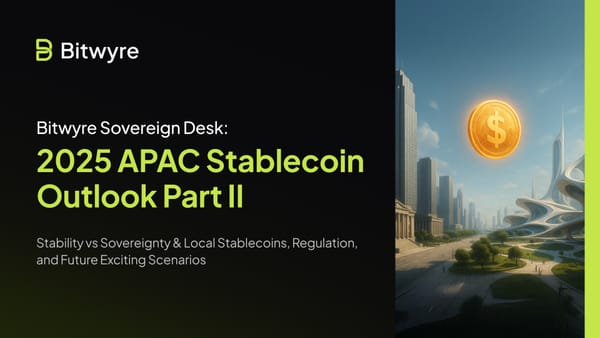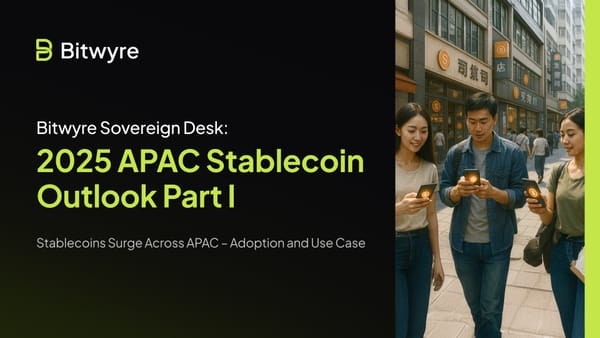Stablecoins for Payments: Nonexistent Then All at Once
The once "idle collateral" Stablecoins now becoming the mainstream backbone of global payments in a quiet, rapid, and irreversible fashion. Here are key developments over the years.

For years, stablecoins like USDT or USDC lived in a paradox: massive market caps and headline-making yield, yet invisible in everyday transactions. More like a vanity project in the seas of other crypto projects and particularly, NFTs - which were not exactly helping people see the stable’s true value.
Valuable but untapped is probably the most apt for stablecoin back in the day. Issuers raked in interest on idle balances, while card rails and traditional payments ruled the real world. That is until everything shifted, suddenly and across multiple fronts.
Welcome to the Sovereign Desk.
Shocking but not really: Amazon and Walmart are reportedly exploring plans to issue their own USD-pegged tokens and directly accept stablecoin payments, aiming to bypass the 1-3% card swipe fees that bleed retail margins. This is a rather obvious start to a closed ecosystem these institutions may be hoping to establish down the line.
We’ve seen similar models before:
- Starbucks pioneered its own “currency” with the Starbucks Card system, locking billions in prepaid balances dubbed “points”.
- Apple Pay gradually turned iPhones into wallets, complete with its own Apple Card.
- Even Alibaba’s Alipay and Tencent’s WeChat Pay in China operate as self-contained monetary ecosystems, which offer payments, loans, wealth products, and insurance inside a single walled garden.
If Amazon or Walmart launches stablecoins, the playbook is quite obvious. Think of controlling the float, owning the network, and reducing reliance on Visa, Mastercard, or even banks altogether. Ambitious? Might be, but the endgame is to make payments become programmable, and loyalty financialized.
However, those plans remain contingent on U.S. legislation like the proposed GENIUS Act, which may signal the beginning of an era when retailers issue real digital currency.
Meanwhile, behind the scenes, Stripe has quietly transformed itself. In October 2024, it acquired blockchain infrastructure company Bridge for $1.1 billion, and not long ago picked up Privy - developers of a wallet onboarding system already integrated in over seventy-five million wallets. They surgically position Stripe as the plumbing provider for embedded and practical stablecoin experiences like payroll, subscriptions, B2B settlements, and beyond.
At the same time, traditional financial institutions are entering the fray. Societe Generale’s SG‑Forge recently launched USD CoinVertible on Ethereum and Solana in partnership with BNY Mellon, the first major USD stablecoin launched by a European bank and fully MiCA-compliant.
Across the continent, Ant Group is pursuing issuance licenses in Hong Kong and Singapore. Coinbase has launched Crypto‑as‑a‑Service tools for banks seeking stablecoin integration. It’s almost like an orchestrated move at this point, smart innovations inside the rails of regulations, all aligned with the legacy systems.
Further innovation comes from the blockchain layer up. New “Stable L1” blockchains back themselves with native USDT gas tokens to enable feeless payments (we’re here now). Fintech startups like Noah, OpenTrade, and Ondo Finance are deploying stablecoin yield and treasury tooling at scale in emerging markets.
Meanwhile, Alchemy Pay is tokenizing dozens of U.S. equities and ETFs, BlackRock’s BUIDL token fund has swelled past $2.9 billion, and Morpho V2 is enabling DeFi loans against real-world collateral.
After years of cautious pilots, stablecoins are transitioning from digital collateral to real-world currency rails. That shift is happening now, and may arrive faster than anyone is expecting.
Now the leading question isn’t whether stablecoin payments will scale, it is becoming mainstream by the second - but “who will own those rails?” and “who will monetize the float?”.
Will Amazon leverage customer data and loyalty with power-issued coins? Will Stripe become the backbone of embedded wallets that process mass payroll and subscriptions?
And just when you thought the stablecoin stage was full, Revolut crashes the party. Revolut is reportedly working on launching its own USD-pegged stablecoin, backed by a massive distribution engine that most issuers envy.
The London-based fintech serves over 55 million retail users and 500,000 businesses across 160 countries. With an annual transaction volume over $20 billion and built-in crypto rails via Revolut X, it already holds the network effect many stablecoin projects can only dream of.
According to Decrypt, If Revolut captures just $7.5 billion in stablecoin float, current Treasury yields could translate to roughly $300 million in annual reserve income. Unlike Circle whose yield is shared with heavy hitters like Coinbase, Revolut owns end-to-end distribution, giving it both margin and control.
The timing couldn't be more striking: the GENIUS Act has now cleared the Senate, and corporate stablecoin fervor is peaking. The neobank could be the first real challenger to the Circle, the Tether duopoly, not just in yield, but in global reach and infrastructure heft.
And what happens if dollar-backed tokens dominate global trade corridors, potentially eroding national FX policy?
For companies and investors, the above comprises a generational moment, to expect hypotheticals will no longer suffice. The rails are being coded in real time, with legislation to heavily shape who can act, and how fast the move is.
The transformation from nonexistent to ubiquitous is underway and already beyond the pilot phase. Remittance corridors are shifting gears. Cross-border B2B invoicing is tentatively tokenized. Commerce platforms are testing stablecoin checkouts. Institutional custody models are solidifying at a lightning fast rate.
If you’re building payments systems, underwriting financial infrastructure, or regulating global capital flow, stablecoins are no longer optional. To move money at a real-time pace, making it global and programmable is central.
So, here’s a bit of a role play for institutions: Where do you stand? Spectating (hopefully not)? Regulating? Building? Moving? Well if you’re thinking about moving, our OTC desk is designed especially for that edge: precision movement of large-scale capital with zero slippage, full discretion, and cross-border capability. Chat our CEO at t.me/dendisuhubdy or the team at [email protected] to start.
The Sovereign Desk editorial is open for conversation. If you’ve observed notable flows, rumours, or data points that warrant attention, please reach out to us:
Dendi Suhubdy at [email protected]
Faisal Mujaddid at [email protected]
Looking to execute large crypto trades with precision, privacy, and zero slippage? Schedule a call with the team at or shoot us an email at [email protected]. Bitwyre’s OTC desk handles high-volume transactions with deep liquidity and bespoke settlement.
We’re also rolling out a stablecoin payments app that lets you bypass OTC entirely, allowing you to use your stablecoins directly for payments at Visa-supported merchants worldwide. Sign up for the waitlist here.




